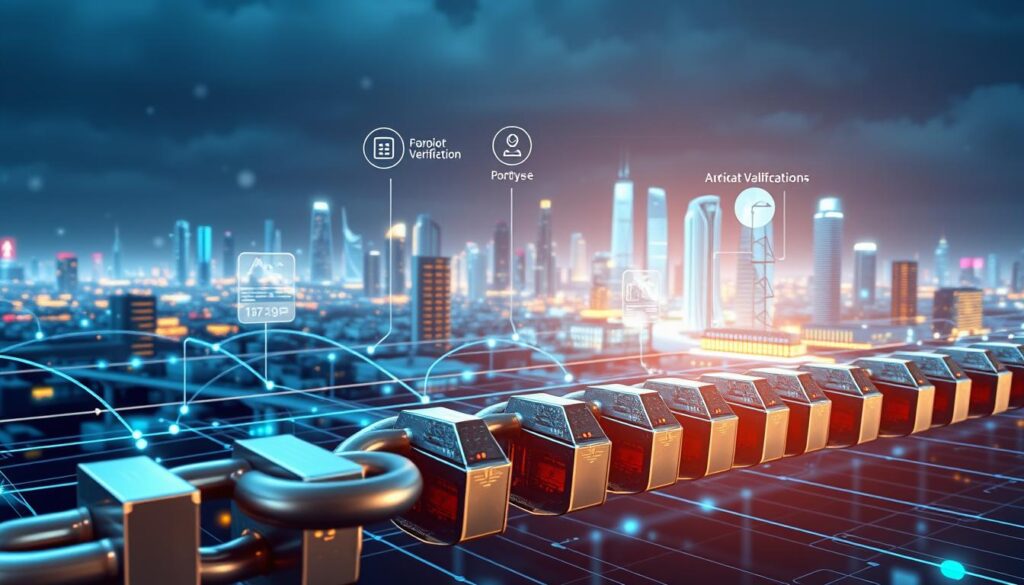Now Reading: Exploring the Convergence of Blockchain and AI
- 01
Exploring the Convergence of Blockchain and AI
Exploring the Convergence of Blockchain and AI
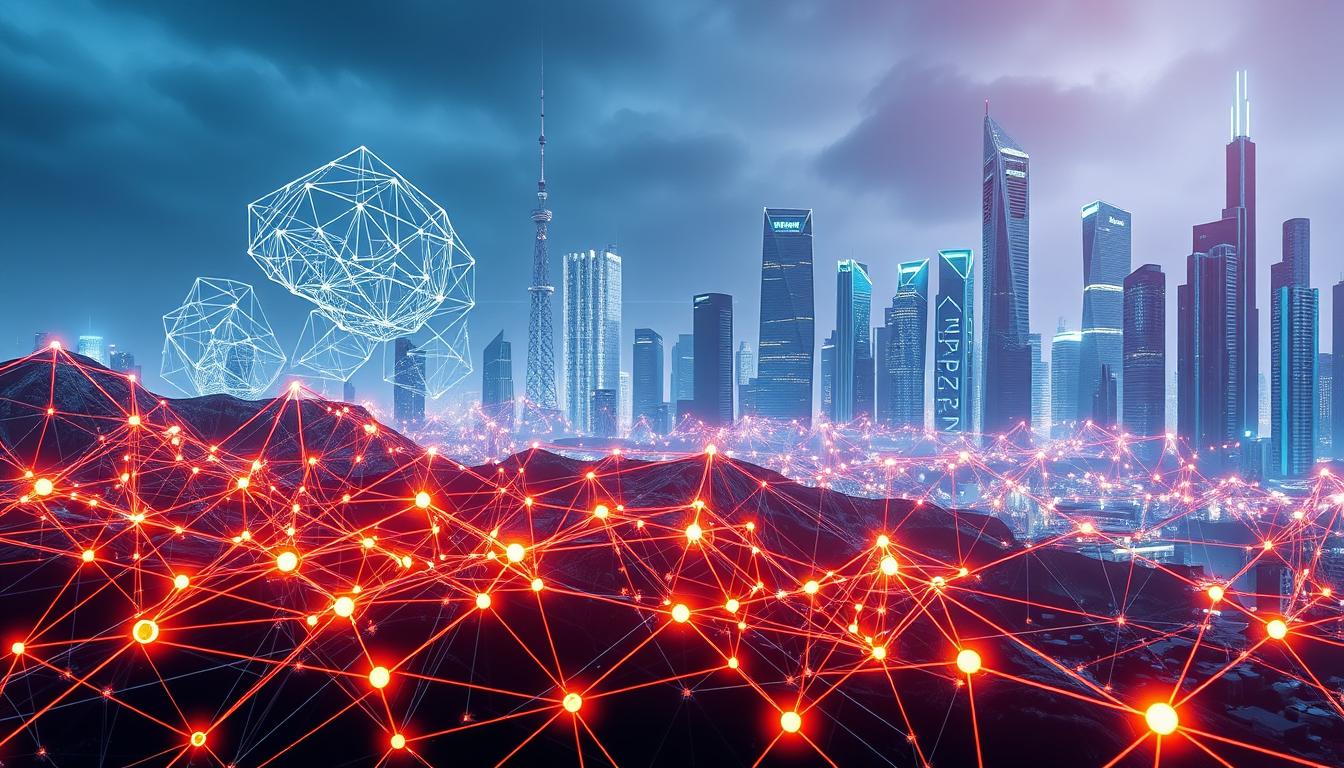
Blockchain and artificial intelligence are coming together to change many industries. They are making data systems more secure and helping make better decisions. The future of these technologies is bright because they can make things more transparent, efficient, and trustworthy.
As Forbes Business Council points out, this mix tackles big problems like keeping data safe and making systems bigger. It also opens up new chances for growth.
Key Takeaways
- Blockchain’s decentralized structure and AI’s analytical power create transformative technologies.
- Combined systems improve data security and automation in sectors like healthcare and finance.
- Market growth in both technologies signals a critical need for businesses to explore their integration.
- Real-world examples show how blockchain and artificial intelligence solve complex operational issues.
- Understanding this convergence is vital for staying competitive in digital transformation.
Understanding the Fundamentals of Blockchain Technology
Blockchain technology is a digital system that records data on a network of computers. It uses cryptography to secure and verify transactions. This makes it a secure way to keep records, which is why it’s used in many areas, like finance and healthcare.
Its security features also make it a great partner for new technologies like AI.
Decentralized Ledger Systems Explained
A decentralized ledger stores data on many nodes, so no one controls it. Each block has transactions linked to the last block through cryptography. For example, Ethereum uses this to track smart contracts and assets in real time.
This system is key for applications like supply chain monitoring. AI can analyze this data for insights.
Smart Contracts and Their Role in Automation
Smart contracts are self-executing agreements in software. They enforce outcomes when conditions are met. Platforms like Ethereum let developers create these contracts to automate tasks.
In projects combining blockchain and AI, these contracts can give AI models access to data. This makes training AI faster and more efficient.
Consensus Mechanisms and Network Security
Networks use consensus algorithms to check transactions. Proof-of-work (PoW) and proof-of-stake (PoS) are two ways to do this. PoW requires solving puzzles, while PoS chooses validators based on their cryptocurrency holdings.
These methods keep transactions secure. This is important when blockchain and AI work together, like in AI-driven financial audits or data verification platforms.
The Evolution of Artificial Intelligence
Artificial intelligence (AI) started as a dream in the 1950s. Now, it’s behind voice assistants and self-driving cars. The Dartmouth Conference in 1956 was a big step. The 2010s saw deep learning and neural networks make AI popular.
AI has different ways to learn: supervised learning uses labeled data, unsupervised learning finds patterns, and reinforcement learning learns by trying. Neural networks, like the human brain, help AI understand images, language, and more.
AI has grown to do more than simple tasks. It can analyze data in real-time and even create new content. This has led to AI working with blockchain, like in AI in blockchain development. AI can make blockchain more energy-efficient, and blockchain keeps AI’s data safe.
AI and blockchain together solve big problems like keeping data private and making things more efficient. This partnership is changing how industries work, making them smarter and more open.
Blockchain and Artificial Intelligence: The Perfect Technological Partnership
When you mix blockchain with artificial intelligence, amazing things happen. Blockchain gives AI a solid base to learn from, thanks to its secure data. At the same time, AI makes blockchain work better and faster. This team-up leads to solutions that are strong and can change as needed.
Complementary Strengths and Capabilities
- Blockchain’s decentralized ledgers make sure data is clear and honest. This lets AI work with trusted info without any bias.
- AI can make blockchain networks better by doing tasks like mining and smart contract execution automatically.
- Together, they build systems that learn from data spread out everywhere while keeping track of everything.
Addressing Individual Technology Limitations
Blockchain helps AI by making sure data is safe and there’s no single weak spot. AI, on the other hand, makes blockchain more efficient by using smart ways to use resources. For instance, IBM uses AI to make its blockchain supply chain network better, saving 30% in energy.
Creating Synergistic Value Through Integration
The mix of blockchain and AI brings big benefits. They help spot fraud right away in finance and share patient data safely in healthcare. This partnership makes systems not just work well but also be reliable. It opens the door to new ideas like self-governing AI markets on platforms like SingularityNET’s decentralized network.
How Blockchain Enhances AI Development
Blockchain AI integration opens up new areas for AI growth. It offers secure ways to share data, solving big problems in AI research. Developers can create systems where data ownership is clear and collaboration is easy.

Secure data sharing is key. Blockchain makes platforms where data can be traded safely. Projects like SingularityNET’s marketplace show how data can be shared while tracking its use.
Decentralized computing power makes AI training easier. Blockchain spreads out tasks, reducing the need for big clouds. Ocean Protocol’s marketplace, for example, links unused resources for faster model training, saving costs for all.
Immutable records solve AI’s “black box” problem. AI decisions are logged on blockchain, making them unchangeable. IBM’s work with Watson and Hyperledger Fabric shows this, making medical AI diagnoses traceable and verifiable.
These steps show blockchain is more than a ledger. It’s a tool for building reliable, growing AI systems. Developers now have the tools to tackle privacy, cost, and transparency issues.
Ways AI Can Optimize Blockchain Networks
AI is changing how blockchain networks work. Machine learning makes key processes smoother. This turns big ideas into real improvements.
For example, AI helps cut down energy use while keeping networks safe. This is a big step towards making blockchain technology better.
- AI looks at transaction data to tweak consensus algorithms on the fly. This cuts down on delays during busy times.
- AI checks smart contracts for bugs before they go live. This helps avoid problems later on.
- AI tools spot odd network behavior fast. They block fake transactions quicker than old methods.
- NLP makes blockchain talk easier. It turns complex tech into simple words for users.
AI also makes upkeep easier. It predicts when hardware might fail or when traffic will spike. This stops networks from crashing.
Companies like Chainlink use AI to check data feeds. This makes sure decentralized systems are accurate. It shows AI and blockchain working together is real and effective.
By combining these technologies, developers make networks that can change on their own. This isn’t just about being fast. It’s about making blockchain reliable for everyday use in finance, healthcare, and more.
Practical Steps for Implementing Blockchain AI Solutions
Starting with blockchain AI solutions means having a clear plan. First, check if your systems and team are ready for this change. Follow these steps to make your strategy work without stopping your work.
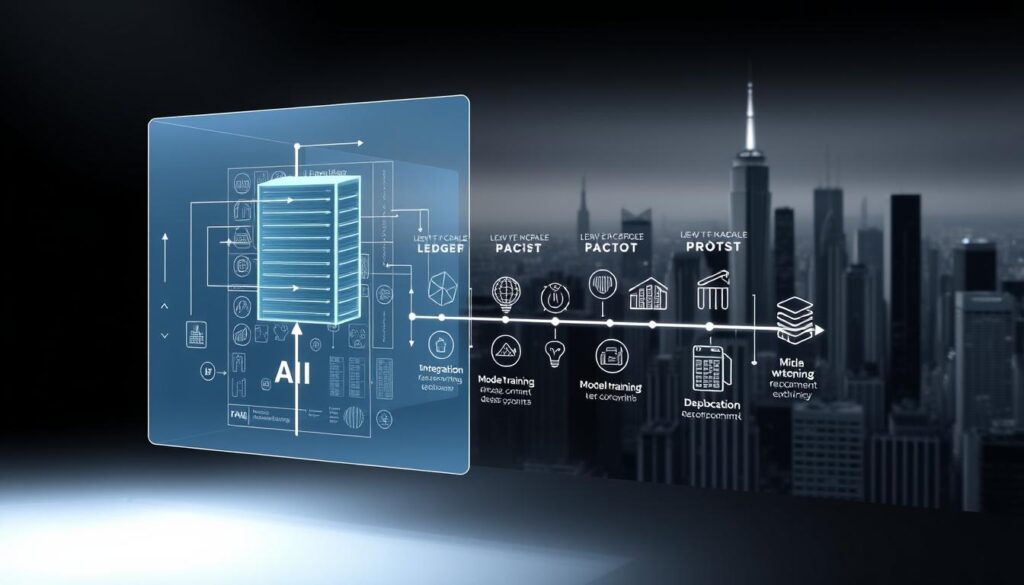
Assessing Organizational Readiness
Start by checking your IT setup. Look at your cloud storage and network security. Make sure your data policies follow rules like GDPR. Find out if you need more skills in blockchain and AI.
Selecting the Right Integration Approach
Choose between making your own blockchain AI integration or using established platforms. IBM’s Hyperledger Fabric is a good choice for big companies. Think about how much you need to grow and the cost of each option.
Building a Cross-Functional Implementation Team
- Blockchain developers with smart contract experience
- Data scientists skilled in machine learning pipelines
- Business analysts to define use-case priorities
- IT security specialists for compliance oversight
Measuring Success and ROI
Watch how fast data is processed and how accurate your models are. Use KPIs like transaction speed and error rates. Show the value of your investment by saving money and making better decisions.
Real-World Applications Across Key Industries
Blockchain technology and artificial intelligence are changing the world. They are making industries like healthcare and energy better. These technologies help make things more efficient, secure, and clear.
Healthcare Data Management and Research
In healthcare, blockchain keeps patient data safe. AI then looks at this data to find trends. Estonia’s e-Health Records use blockchain to check data’s integrity.
AI helps predict disease outbreaks. This speeds up finding new drugs by 30% in trials.
Financial Services and Fraud Prevention
JPMorgan Chase uses blockchain and AI to spot fraud. AI finds odd patterns quickly. Blockchain keeps a record that can’t be changed.
This cut down on false alarms by 40% in 2023. It saved millions of dollars in recovery costs.
Supply Chain Transparency and Optimization
Maersk’s TradeLens tracks shipments with blockchain. AI predicts when things will arrive. This combo cut shipping delays by 20%.
It also saved global retailers like Walmart $200 million a year. This is because of lower inventory costs.
Energy Grid Management and Trading
Power Ledger’s platform lets people trade energy directly. It uses blockchain for smart contracts and AI to manage the grid. In Australia, this cut energy waste by 15%.
This saved money for both homes and utilities.
Overcoming Common Challenges in Blockchain and AI Integration
Integrating blockchain and AI faces many hurdles. Technical issues like scalability and interoperability are big problems. For example, AI needs lots of computing power, but blockchain’s high energy use and slow speeds can be a mismatch.
Companies like IBM use hybrid cloud solutions. They mix decentralized ledgers with AI on scalable servers. This helps overcome some of these technical barriers.
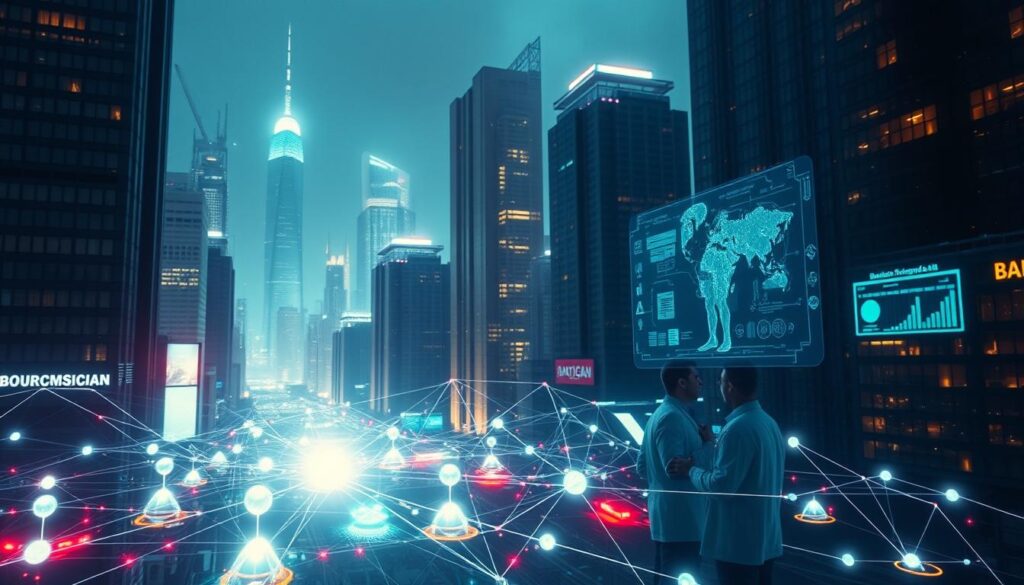
There are also gaps in interoperability between AI and blockchain. For instance, AI frameworks like TensorFlow don’t always work well with blockchain platforms like Ethereum. To solve this, tools like Chainlink help connect smart contracts to real-world data.
Privacy is another big issue. Data used in AI training must follow rules like GDPR. Zero-knowledge proofs and federated learning help keep data private while keeping AI models accurate.
- Technical Fixes: Optimize consensus algorithms (e.g., Proof-of-Stake) to reduce latency.
- Team Collaboration: Train staff in both blockchain and machine learning to bridge knowledge gaps.
- Regulatory Clarity: Monitor evolving standards like the EU’s Digital Operational Trust Framework to align projects with compliance.
Companies should focus on testing in small steps. Start with simple projects, like tracking supply chains, and then grow. By tackling these challenges, businesses can fully benefit from blockchain and AI without wasting resources.
Essential Tools and Platforms for Developers
Developing blockchain AI solutions needs strong tools for easy integration. Developers require frameworks, platforms, and testing environments. These tools help in working together smoothly.
Open-Source Frameworks Worth Exploring
Begin with open-source options like Hyperledger Fabric for smart contracts. Or Ethereum with its wide AI plugin ecosystem. Libraries like TensorFlow and PyTorch now work with blockchain, allowing model training on networks.
These tools give basic code structures but keep room for custom workflows. This flexibility is key for AI-blockchain projects.
Commercial Solutions for Enterprise Implementation
- IBM’s AI-powered blockchain platforms integrate Watson AI with Hyperledger for top security
- Microsoft Azure’s blockchain templates make deploying AI models easy on decentralized networks
- Amazon Web Services (AWS) has managed blockchain AI solutions with ready-to-use machine learning pipelines
Startups like SingularityNET offer marketplaces for AI algorithms via blockchain smart contracts. This shows how blockchain technology applications work in real AI markets.
Development Environments and Testing Tools
Use IDEs like Visual Studio Code with blockchain extensions for smart contract debugging. Tools like Ganache simulate blockchain environments for testing AI model interactions. Platforms like Chainlink let developers test decentralized AI workflows before they go live.
Using these tools together makes a smooth workflow. It helps blockchain AI solutions go from idea to reality quickly.
Regulatory Considerations and Compliance Strategies
As blockchain and artificial intelligence grow, understanding rules is key. Governments are making laws to guide innovation. In the future of blockchain and artificial intelligence, knowing laws like GDPR in the EU and US rules is crucial.
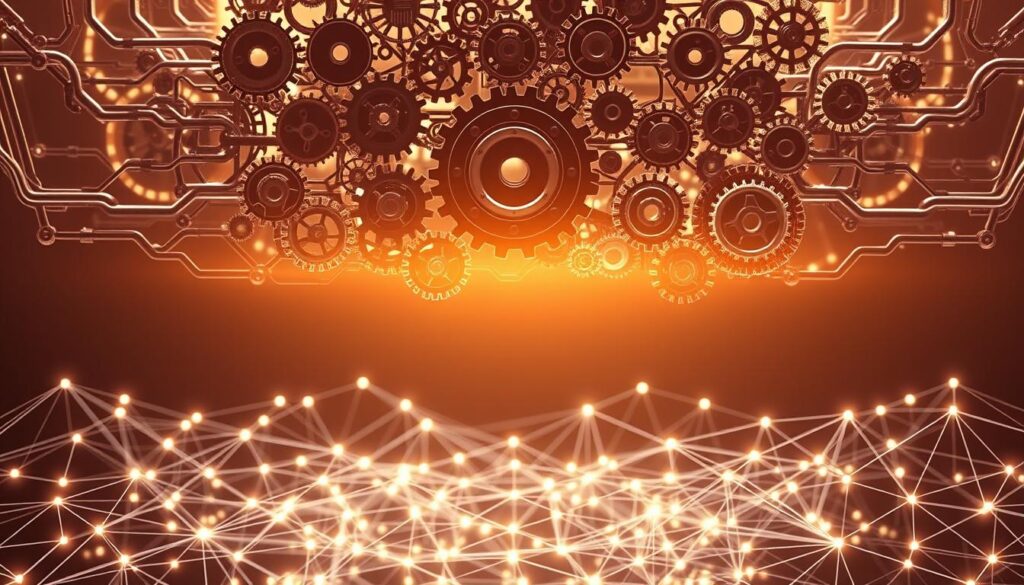
- Data Protection: Blockchain’s permanent records must follow privacy laws. For example, GDPR demands tracking consent and deleting data, even in decentralized systems.
- Financial Regulations: Cryptocurrency and AI trading platforms need strict licenses and anti-money laundering checks in places like the U.S. and EU.
- AI Governance: The EU’s proposed AI Act sorts systems by risk. It requires audits for high-risk uses like healthcare diagnostics with blockchain-AI.
Compliance strategies should include:
- Keeping records of data flows and AI decision paths
- Creating audit trails for smart contracts and AI training data
- Following ethical guidelines to avoid AI bias
Healthcare and finance get extra attention. For instance, HIPAA in U.S. healthcare requires secure sharing of patient data via blockchain. AI then analyzes these trends. Companies must stay ready for new laws. Keeping up with changing rules is vital as regulators adapt to blockchain and artificial intelligence.
The Economic Impact of Combining Blockchain with Artificial Intelligence
The benefits of blockchain and AI go beyond just tech. They change the way we do business. Companies using these tools see big returns, thanks to better operations and new ways to make money.
Cost Reduction Through Process Automation
Automation with blockchain systems cuts costs. For example, smart contracts in supply chains save up to 40% on manual work. AI also helps use resources better, like cutting data center energy use by 25%.
New Business Models and Revenue Streams
- Data Marketplaces: Places like Ocean Protocol let users sell data for AI training. This creates a new way to make money.
- Tokenized Services: AI models on blockchain make money through small payments for predictions.
- Smart Contracts: These automate billing and checks, saving money and reaching more customers worldwide.
Competitive Advantages in Digital Transformation
Companies like IBM, which combined Watson AI with blockchain, launched products 30% faster. They also saw a 22% boost in customer trust and 15% less fraud. This puts them ahead in finance and healthcare.
Using these technologies is more than just an upgrade. It’s a smart choice. Companies see an 18% average ROI increase each year. This shows how well blockchain and AI work together for growth.
Privacy and Security Enhancements Through Dual Technology Implementation
Using blockchain and AI together makes security stronger. These solutions use encryption and decentralized systems to keep data safe. For example, homomorphic encryption lets AI work with encrypted data without seeing the real information.
Zero-knowledge proofs help check data without sharing private details. These steps protect against hackers and unauthorized access.
- Homomorphic encryption: Allows AI models to process data without decryption.
- Zero-knowledge proofs: Verify transactions or outcomes without revealing underlying data.
- Confidential computing: Secures AI training processes using hardware-based isolation.
AI checks blockchain networks for oddities like fake transactions or smart contract bugs. Blockchain keeps AI models safe by making them unchangeable. This stops hackers from messing with AI systems.
By using these benefits of blockchain and AI, companies can lower risks like data poisoning or model theft. This makes privacy and security key parts of the system, not just add-ons. Businesses should focus on combining these technologies to keep up with cybersecurity needs and customer trust.
Case Studies: Successful Blockchain AI Projects
Real-world uses of blockchain AI solutions show how decentralized systems and machine learning can work together. These examples look at the tech and business sides, showing how blockchain and AI are getting better. Here are three projects that are leading the way in this field.
SingularityNET’s Decentralized AI Marketplace
SingularityNET’s platform is a global marketplace for AI services, using blockchain. Developers can put their algorithms on the platform through smart contracts. This makes it easier and cheaper for businesses to get AI tools.
- Technical: Decentralized network with AGIX cryptocurrency for payments
- Challenges: Scaling user adoption in regulated industries
- Outcomes: 500+ developers and partnerships with Fortune 500 firms
IBM’s Hyperledger and Watson Integration
IBM combined Hyperledger Fabric with Watson AI to keep healthcare data safe. This mix helped spot fraud in financial deals right away. It also made sure the data was safe under HIPAA rules.
- Technical: Permissioned blockchain for data integrity
- Challenges: Synchronizing AI analysis with blockchain ledgers
- Outcomes: Reduced data reconciliation time by 40% for clients
Ocean Protocol’s Data Exchange Platform
Ocean Protocol’s blockchain platform lets AI training data be shared safely. It uses special tech to let researchers use data without seeing the raw data. This helps AI grow in a way that respects privacy.
- Technical: Data NFTs track usage rights
- Challenges: Balancing data utility with GDPR compliance
- Outcomes: Powered drug discovery projects in biotech sectors
These examples show how blockchain AI solutions can solve big problems in different fields. They show the progress in blockchain and AI, giving us ideas for the future.
Charting Your Path Forward in the Blockchain-AI Ecosystem
The future of blockchain and AI depends on smart planning. Start by seeing how combining these technologies can solve your company’s problems. Begin with small tests, like using decentralized platforms for secure data sharing.
Keep up with the latest by attending events like the IEEE Blockchain Summit. Also, follow research from MIT’s Digital Currency Initiative. Subscribing to Blockchain: Research and Applications keeps you updated on new rules and tech.
To grow in this field, learn about blockchain and AI tools. Get certified in TensorFlow and Hyperledger Fabric. Join groups like the Ethereum Developer Forum to meet others working on similar projects.
New trends include AI-enhanced consensus algorithms and blockchain data markets. As these grow, more industries will use them. Companies that start early will lead in automation and security.
Success in this area needs curiosity, teamwork, and a spirit of trying new things. These qualities are essential for excelling in this changing world.
FAQ
What is the integration of blockchain and artificial intelligence?
Blockchain and artificial intelligence (AI) work together to make data safer and more efficient. They use decentralized systems for secure data sharing. AI then analyzes this data, offering insights and automating tasks.
What are some benefits of integrating AI with blockchain technology?
Combining AI with blockchain improves data security and transparency. It also automates complex tasks. This partnership reduces costs and increases trust, making systems more efficient.
How can blockchain enhance AI development?
Blockchain offers secure data sharing platforms for AI. It also provides decentralized computing resources, cutting costs for AI model training. This ensures AI decisions are documented and auditable.
What are the real-world applications of blockchain and AI integration?
Blockchain and AI are used in healthcare for secure data sharing. They help in financial services for fraud detection and in supply chain management for tracking products. They also improve energy grid management, enhancing energy trading and usage.
What challenges are associated with blockchain and AI integration?
Challenges include scalability and interoperability issues. There are also data privacy concerns. Organizations face talent acquisition challenges and regulatory uncertainties as these technologies evolve.
What tools and platforms are available for developing integrated blockchain-AI applications?
Developers use open-source frameworks like Hyperledger Fabric and TensorFlow. Commercial solutions from IBM and Microsoft are also available. There are development environments and testing tools to help create these applications.
How does the convergence of blockchain and AI impact privacy and security?
Blockchain and AI together enhance privacy and security. They use homomorphic encryption to analyze data without exposing it. Blockchain also secures AI models and detects vulnerabilities, making the ecosystem more resilient.
What are some successful case studies of blockchain-AI integration?
SingularityNET is a decentralized AI marketplace. IBM’s Hyperledger Fabric with Watson AI offers enterprise solutions. Ocean Protocol creates secure data exchange platforms for AI training. These projects show the practical benefits of combining these technologies.


